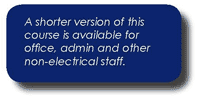What do candidates on the EAW Regulations course actually do?
The EAW Regs course is often 'tuned' to suit the audience and our instructors like to get feedback from the candidates as the course progresses but the following gives a general breakdown of the main parts of the course.
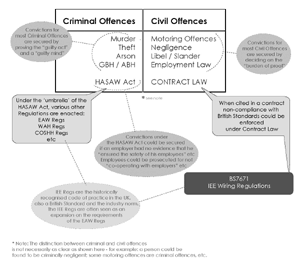
The Legal Implications: We begin by analysing the legal situation regarding the Electricity at Work Regulations. Candidates learn about the relationships between the relevant legal Acts, codes of practice and regulations (the Health & Safety at Work Act, the IEE Wiring Regulations etc).
Candidates are engaged in this part of the course by exploring the various scenarios that might arise - for example: Would non-compliance with the EAW Regs be a criminal or a civil offence? In what situations would compliance with the EAW regulations be necessary? Would a defence be needed to prove compliance with the EAW Regulations?
This analysis of the legal situation helps the candidates to clearly see the scope of the regulations - who, where and what they apply to. A syndicate exercise is staged here to help to reinforce these issues.
We then look at the broad subject area of the regulations so that the candidates can start to understand what the regulations cover and (in general) what the Regulations are trying to achieve. The definitions are then clearly explained - this is important as the meaning of 'live' or 'charged', for example, can have far-reaching implications when considered in the context of the specific requirements of the individual EAW regulations when they are studied later on in the course.
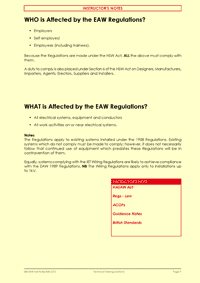 |
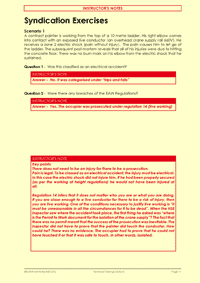 |
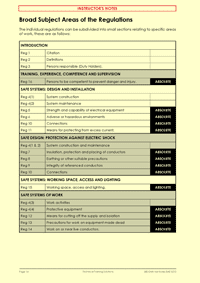 |
Page 10 of the course notes for the EAW Regulations course, describing who and what is affected by the Regulations |
Page 11 of the course notes for the EAW Regulations course, where we introduce syndicate exercises to engage the candidates in thinking about what the Regulations would have to say about various scenarios |
Page 12 of the course notes for the EAW Regulations course, listing the broad subject areas of the Regulations and highlighting which regulations are absolute requirements |
A structured slide-show is used by our instructors to help convey the meaning of each of the EAW Regulations. Candidates can read the exact wording of the Regulations provided in the course notes and then discuss what this means in reality.
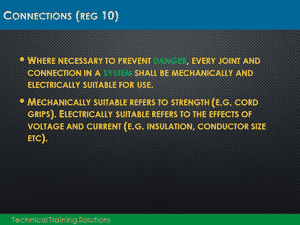 |
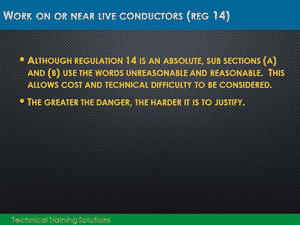 |
One of the Slides used for the EAW Regulations course, explaining the requirements made by the EAW Regulations with regard to electrical connections |
One of the Slides used for the EAW Regulations course, explaining what the EAW Regulations mean by working live |
We then look at the issues surrounding the term 'duty holder' referred to in the EAW Regulations. This is an important concept as the candidates need to be made aware who might be held legally responsible. It is also important that candidates gain a proper understanding of the effects of electric shock, and this subject is taught next, with research information and graphs shown of the known effects of electric shock in the candidates' course notes.
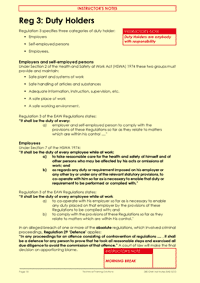 |
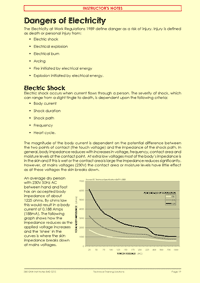 |
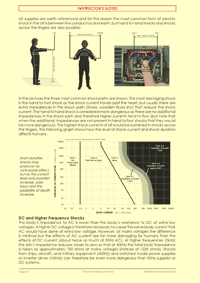 |
Page 13 of the course notes for the EAW Regulations course, describing the term 'duty holder' used in the Regulations |
Page 14 of the course notes for the EAW Regulations course, explaining the effects of electric shock |
Page 15 of the course notes for the EAW Regulations course, explaining the effects of electric shock |
We also show the candidates a short video which helps to explain the regulations in a slightly different context. The following are screen shots from this video, depicting the issues of live working.
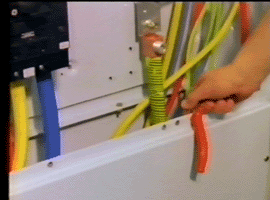 |
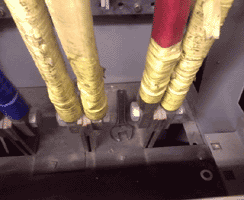 |
Part of the video used for the EAW Regulations course, depicting some of the issues surrounding live working |
Part of the video used for the EAW Regulations course, depicting some of the issues surrounding live working |
We then look at the important issues surrounding the term 'competence' referred to in the EAW Regulations. We look at how this relates to the candidates' work activities and the issues of supervision etc. The next regulations we study are regarding the issues of insulation, earthing and isolation. The following are extracts from the candidates' course notes.
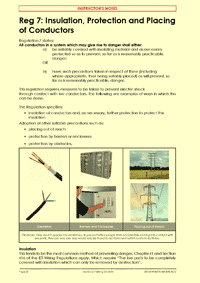 |
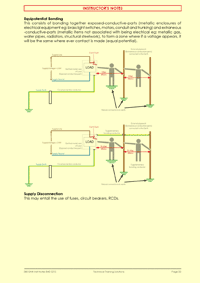 |
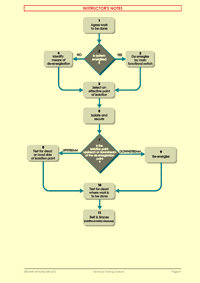 |
Page 24 of the course notes for the EAW Regulations course, describing the various ways that the Regulations require prevention from electric shock to be achieved |
Page 27 of the course notes for the EAW Regulations course, explaining the methods by which earthing is used to reduce or eliminate the effects of electric shock |
Page 35 of the course notes for the EAW Regulations course, explaining the methods by which electrical isolations may be achieved |
The course finishes by summarising each of the regulations that have been taught and reminding the candidates what they should have learned from them. The course notes provide a useful short summary of all the EAW Regulations. In order to ensure that the candidates have understood each of the key objectives of the course properly, we issue a multiple-choice assessment paper which they have to answer and return to our instructor. The instructor then fully debriefs each and every question, ensuring that every single candidate has understood all of the important points of the day.
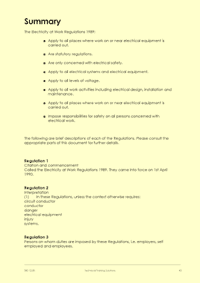 |
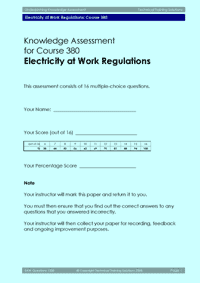 |
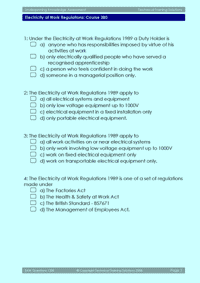 |
Page 43 of the course notes for the EAW Regulations course, providing a summary of the requirements of each of the EAW Regulations |
Front page of the course assessment of the EAW Regulations course, explaining the marking system and the instructions to the candidates |
Page 2 of the multiple-choice assessment paper used on the EAW Regulations course: There are 15 questions in all |
If you would like to learn more about the EAW Regulations course then please call us.


